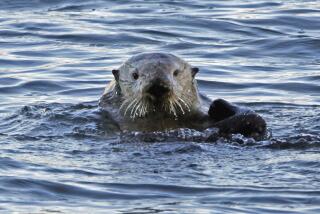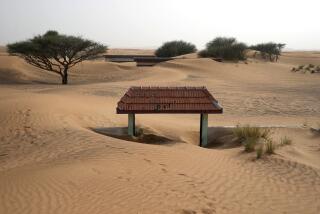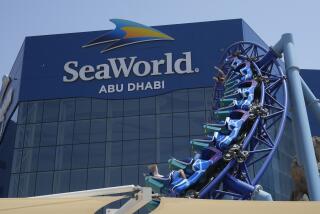Persian Gulf Development May Doom Rare Species
- Share via
KHOR KALBA, United Arab Emirates — It’s one of the world’s rarest birds, but there it sat on a mangrove branch, motionless, eyes peeled for a fiddler crab.
The handsome white-collared kingfisher, its iridescent green back flickering in the dappled 110-degree sunshine, suddenly disappeared. A loud splash came from the swampy thicket. A millisecond later, the bird flashed past, on its way to a hideaway to crunch a live crab in its sharp black beak.
Although the kingfisher is a common bird, only a few dozen of its Arabian subspecies, kalbaensis, are thought to remain on the planet, since their nesting places are restricted to the hollows of knotty old mangroves.
Conservationists here worry that relentless real estate encroachment could push the kalbaensis into extinction.
Already it has only three known nesting grounds: this ancient mangrove swamp 80 miles from Dubai and two smaller ones just across the border in Oman. All three are threatened by Florida-style luxury resorts and housing along hundreds of miles of once pristine Arabian coastline.
The kingfisher is just one of the species threatened by the building boom. In Oman, a luxury hotel was just finished on a stretch of beach used as a nesting site for the critically endangered hawksbill turtle. Other developments have taken habitat from the rare Socotra cormorant and the dugong, or sea cow, a marine mammal akin to the manatee.
Of the Khor Kalba kingfishers, “there’s around 40 pairs there and half a dozen in Oman, and that’s it -- in the world,” said Peter Hellyer of the Emirates Bird Records Committee. “If that population is put under excessive pressure, you could wipe out an entire subspecies.”
Unfortunately for the kingfisher, a United Nations plan to protect the mangroves as a biosphere reserve appears to have been scuttled by the emirate of Sharjah, which allowed the dredging of a channel that bisects the wetland and construction of an adjacent concrete walkway. Hellyer and others say the dredging could eventually kill the mangroves by changing currents or blocking the supply of fresh water.
Telephone calls and e-mails seeking an explanation from Sharjah’s environment minister, Abdul Aziz Medfa, went unanswered.
Visitors to the Khor Kalba mangroves in June found them open to swimmers and groups of men in four-wheel-drives who picnicked in the shade listening to loud music.
Environmental watchdogs in Arabia are few, and they acknowledge that they stand little chance against developers, many of whom have connections with the royal family and huge energy profits to invest.
In Dubai, a designated wildlife zone with coral reefs and sea grasses was buried beneath a man-made island. A mangrove and flamingo sanctuary in Dubai has just been rezoned for a luxury development dubbed the Lagoons. And a giant mangrove flat at nearby Umm al Qaiwain is being developed as a marina and resort.
“We try to be positive. But sometimes for your own sanity you block out what’s going on,” said Habiba Marashi, chairwoman of the Emirates Environmental Group. “In the end I can only do so much.”
In Oman, developers of the Shangri-La Barr al Jissah resort were asked to move the hotel back from the beach so its lighting wouldn’t interfere with hawksbill turtle nesting, but that didn’t happen, said Earl Possardt, a turtle specialist with the U.S. Fish and Wildlife Service who consulted with Omani environmental authorities.
Now, Possardt says, conservationists are worried about further bulldozing of Oman’s beaches, still some of the world’s most important nesting grounds for the green and loggerhead turtles.
“Oman is still a beautifully intact country. But they’ve got humongous plans for development coming up. I’m afraid they’re going to be overrun,” Possardt said by telephone from his office in Georgia. “What’s at stake is losing one of the world’s premier loggerhead nesting populations and some of the region’s best green turtle populations.”
Besides beaches, the Persian Gulf’s delicate mangrove wetlands are in demand for luxury housing. Mangroves, which are thought to require tidal flow and a combination of fresh and salt water, are nurseries for crabs, small fish and insects -- and the birds that eat them. Hundreds of thousands of birds stop in Arabian mangroves while migrating between Africa and Asia.
Developers like mangroves because adjacent homes can sit within eyeshot of the wildlife, or that portion that isn’t chased away.
“These are some of the world’s great nesting areas. If you start taking their habitat and food resources, it can affect not just individual birds but the entire population,” said David Aubrey, chief executive of the Woods Hole Group, a U.S. environmental survey firm working in Saudi Arabia. “It takes a high level of diligence and planning to retain mangroves, and those aren’t features you associate with the rapid development along the UAE coast.”
In Khor Kalba, schools of tiny fish splash among the mangrove roots where crabs retreat from their burrows at high tide. But the kingfisher’s presence seems less assured.
In 1997, when Dubai filmmaker Yusuf Thakur spent five steamy months filming a documentary on the white-collared kingfisher, he counted 14 breeding pairs in the muddy thickets.
Returning in March, he found the wetland sliced in half by construction and only two pairs of kingfishers nesting in mangroves that previously held eight pairs.
The kingfisher’s two other mangrove haunts also are targeted for development. A nesting ground at Liwa in Oman lies close to construction of a new port at Sohar. Its other home at Shinas is threatened by a planned resort, said Ian Harrison of the Oman Bird Group.
Harrison said the same developments also menaced Oman’s only populations of the booted warbler, a shy and rare bird that also preferred life in the shade of the mangrove.
More to Read
Sign up for Essential California
The most important California stories and recommendations in your inbox every morning.
You may occasionally receive promotional content from the Los Angeles Times.













